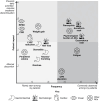Consensus recommendations on management of selumetinib-associated adverse events in pediatric patients with neurofibromatosis type 1 and plexiform neurofibromas
- PMID: 39279781
- PMCID: PMC11398946
- DOI: 10.1093/nop/npae038
Consensus recommendations on management of selumetinib-associated adverse events in pediatric patients with neurofibromatosis type 1 and plexiform neurofibromas
Abstract
Background: Selumetinib is the first approved treatment for pediatric patients with neurofibromatosis type 1 (NF1) and symptomatic, inoperable plexiform neurofibromas (PN) in the EU and US, as well as in multiple other countries. Evidence for the management of selumetinib-associated adverse events (AEs) is mostly limited to clinical trials and expanded-access programs. We gathered a panel of European healthcare practitioners with clinical experience prescribing selumetinib and/or managing pediatric patients with NF1-PN to provide recommendations on the prevention and management of AEs.
Methods: A modified Delphi approach was used to develop the recommendations among the group of experts. Initial statements were developed from a literature review of current management recommendations and regulatory reports. The panel refined the statements and rated the extent to which they agreed with them in 2 sessions and a follow-up survey. The panel comprised 2 pediatric neuro-oncologists, 1 pediatric oncologist, 1 pediatrician, 1 neuropediatrician, 1 oncologist, 1 neurologist, 2 psychologists, and 1 dermatologist.
Results: The experts agreed on the relative frequency and impact of AEs potentially associated with selumetinib. Consensus-level agreement was reached for 36 statements regarding the prevention and management of AEs potentially associated with selumetinib. Experts recommended treatments for AEs based on their experience.
Conclusions: The development of a variety of consensus statements indicates expert agreement on best practices for the prevention and management of AEs potentially associated with selumetinib in pediatric patients with NF1-PN. These events are generally manageable and should be considered alongside treatment benefit. Information sharing is warranted as further experience is gained.
Keywords: adverse event management; neurofibromatosis type 1; pediatric; plexiform neurofibromas; selumetinib.
© The Author(s) 2024. Published by Oxford University Press on behalf of the Society for Neuro-Oncology and the European Association of Neuro-Oncology.
Conflict of interest statement
A.A.A.: Member of advisory boards, and received scientific grants, speaker honoraria, travel support, and payments for workshop participation from Alexion. Member of Novartis advisory board. C.S.: Received payment for scientific consultation and speaker honoraria from Alexion/AstraZeneca. Participated on a data safety monitoring/advisory board for Alexion/AstraZeneca. Received payment for scientific consultation from IQVIA. Held a leadership or fiduciary role for ANF patient advocacy. D.H.: Member of advisory boards, and received research grants, speaker honoraria, materials for clinical trials, institutional clinical trial support, and travel support from Alexion/AstraZeneca. H.S.H.: Alexion/AstraZeneca advisory board, speaker honoraria, travel support, and consulting fees. J.P.: Alexion consulting fees, honoraria, travel expenses, participation on a data safety monitoring/advisory board. P.A.A.: Grants/contracts from Bristol Myers Squibb, Roche-Genentech, Pfizer/Array, and Sanofi. Consulting fees from Bristol Myers Squibb, Roche-Genentech, Merck Sharp & Dohme, Novartis, Merck Serono, Pierre-Fabre, Sun Pharma, Sanofi, Idera, Sandoz, 4SC, Italfarmaco, Nektar, Pfizer/Array, Lunaphore, Medicenna, Bio-Al Health, ValoTx, Replimmune, and Bayer. Support for attending meetings and/or travel from Pfizer, Bio-Al Health, and Replimmune. Participation on data safety monitoring/advisory boards from Bristol Myers Squibb, Roche-Genentech, Merck Sharp & Dohme, Novartis, AstraZeneca, Immunocore, Boehringer Ingelheim, Eisai, Regeneron, Daiichi Sankyo, Oncosec, Nouscom, Seagen, iTeos, and Erasca. Member of advisory boards for Alexion. P.W.: Consulting fees, speaker payment/honoraria and logistical support from, and member of advisory boards for Alexion. Received consulting fees and speaker honoraria from AstraZeneca. Received consulting fees from SpringWorks. T.P.: Received consulting fees from, and was a member of advisory boards for, Alexion. Received grants from NF Kinder. T.R.: Member of advisory boards and participated on a data safety monitoring/advisory board for, and received speaker honoraria, travel support, personal payments, grants/contracts, and consulting fees from Alexion/AstraZeneca. Received payment/honoraria from the Taiwan Society for Pediatric Neurosurgery. Unpaid leadership/fiduciary role for the German Society for Neuropediatrics, NF Working Group Germany. V.R.: Received consulting fees and was a member of advisory boards for Alexion. An unpaid board member of psychosocial working group for Psychosoziale Arbeitsgemeinschaft in der Gesellschaft für Pädiatrische Onkologie und Hämatologie (PSAPOH) Gesellschaft für Pädiatrische Onkologie und Hämatologie (GPOH).
Figures



References
Publication types
LinkOut - more resources
Full Text Sources
Research Materials
Miscellaneous

